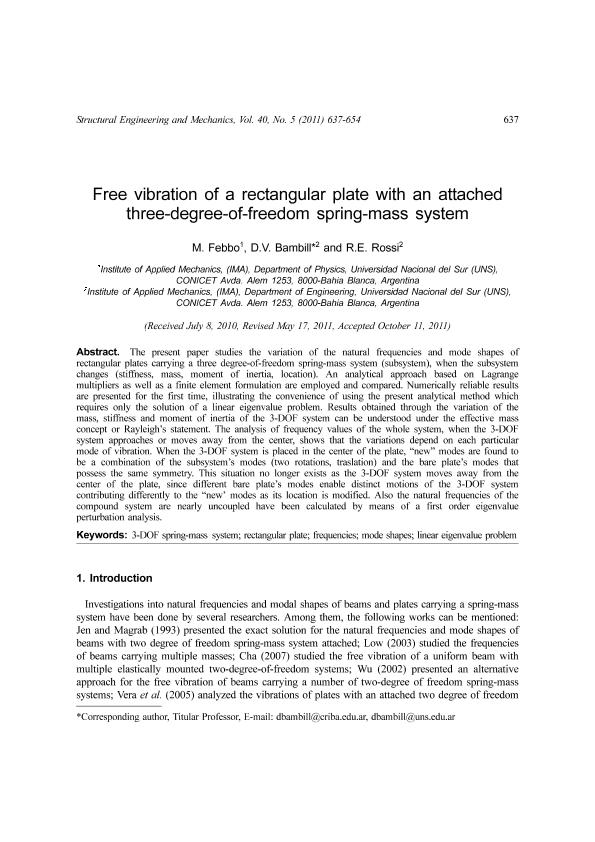Mostrar el registro sencillo del ítem
dc.contributor.author
Febbo, Mariano

dc.contributor.author
Bambill, Diana Virginia

dc.contributor.author
Rossi, Raul Edgardo

dc.date.available
2019-01-02T15:58:58Z
dc.date.issued
2011-12
dc.identifier.citation
Febbo, Mariano; Bambill, Diana Virginia; Rossi, Raul Edgardo; Free vibration of a rectangular plate with an attached three-degree-of-freedom spring-mass system; Techno-Press; Structural Engineering And Mechanics; 40; 5; 12-2011; 637-654
dc.identifier.issn
1225-4568
dc.identifier.uri
http://hdl.handle.net/11336/67192
dc.description.abstract
The present paper studies the variation of the natural frequencies and mode shapes of rectangular plates carrying a three degree-of-freedom spring-mass system (subsystem), when the subsystem changes (stiffness, mass, moment of inertia, location). An analytical approach based on Lagrange multipliers as well as a finite element formulation are employed and compared. Numerically reliable results are presented for the first time, illustrating the convenience of using the present analytical method which requires only the solution of a linear eigenvalue problem. Results obtained through the variation of the mass, stiffness and moment of inertia of the 3-DOF system can be understood under the effective mass concept or Rayleigh’s statement. The analysis of frequency values of the whole system, when the 3-DOF system approaches or moves away from the center, shows that the variations depend on each particular mode of vibration. When the 3-DOF system is placed in the center of the plate, “new” modes are found to be a combination of the subsystem’s modes (two rotations, traslation) and the bare plate’s modes that possess the same symmetry. This situation no longer exists as the 3-DOF system moves away from the center of the plate, since different bare plate’s modes enable distinct motions of the 3-DOF system contributing differently to the “new’ modes as its location is modified. Also the natural frequencies of the compound system are nearly uncoupled have been calculated by means of a first order eigenvalue perturbation analysis.
dc.format
application/pdf
dc.language.iso
eng
dc.publisher
Techno-Press

dc.rights
info:eu-repo/semantics/openAccess
dc.rights.uri
https://creativecommons.org/licenses/by-nc-sa/2.5/ar/
dc.subject
3-Dof Spring-Mass-System
dc.subject
Rectangular Plate
dc.subject
Frequencies
dc.subject
Mode Shapes
dc.subject
Linear Eigenvalue Problem
dc.subject.classification
Ingeniería Mecánica

dc.subject.classification
Ingeniería Mecánica

dc.subject.classification
INGENIERÍAS Y TECNOLOGÍAS

dc.title
Free vibration of a rectangular plate with an attached three-degree-of-freedom spring-mass system
dc.type
info:eu-repo/semantics/article
dc.type
info:ar-repo/semantics/artículo
dc.type
info:eu-repo/semantics/publishedVersion
dc.date.updated
2018-11-21T16:56:19Z
dc.journal.volume
40
dc.journal.number
5
dc.journal.pagination
637-654
dc.journal.pais
Corea del Sur

dc.description.fil
Fil: Febbo, Mariano. Consejo Nacional de Investigaciones Científicas y Técnicas. Centro Científico Tecnológico Conicet - Bahía Blanca. Instituto de Física del Sur. Universidad Nacional del Sur. Departamento de Física. Instituto de Física del Sur; Argentina
dc.description.fil
Fil: Bambill, Diana Virginia. Universidad Nacional del Sur; Argentina. Consejo Nacional de Investigaciones Científicas y Técnicas; Argentina
dc.description.fil
Fil: Rossi, Raul Edgardo. Universidad Nacional del Sur; Argentina. Consejo Nacional de Investigaciones Científicas y Técnicas; Argentina
dc.journal.title
Structural Engineering And Mechanics

dc.relation.alternativeid
info:eu-repo/semantics/altIdentifier/url/http://koreascience.or.kr/article/JAKO201115541089340.page
dc.relation.alternativeid
info:eu-repo/semantics/altIdentifier/doi/http://dx.doi.org/10.12989/sem.2011.40.5.637
Archivos asociados
